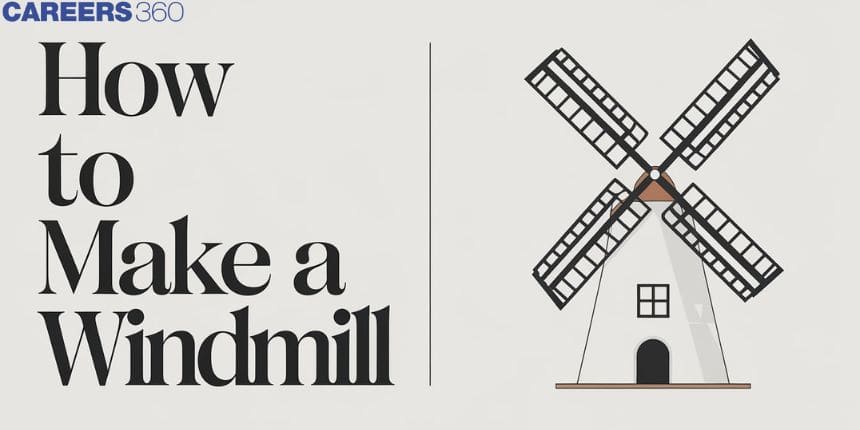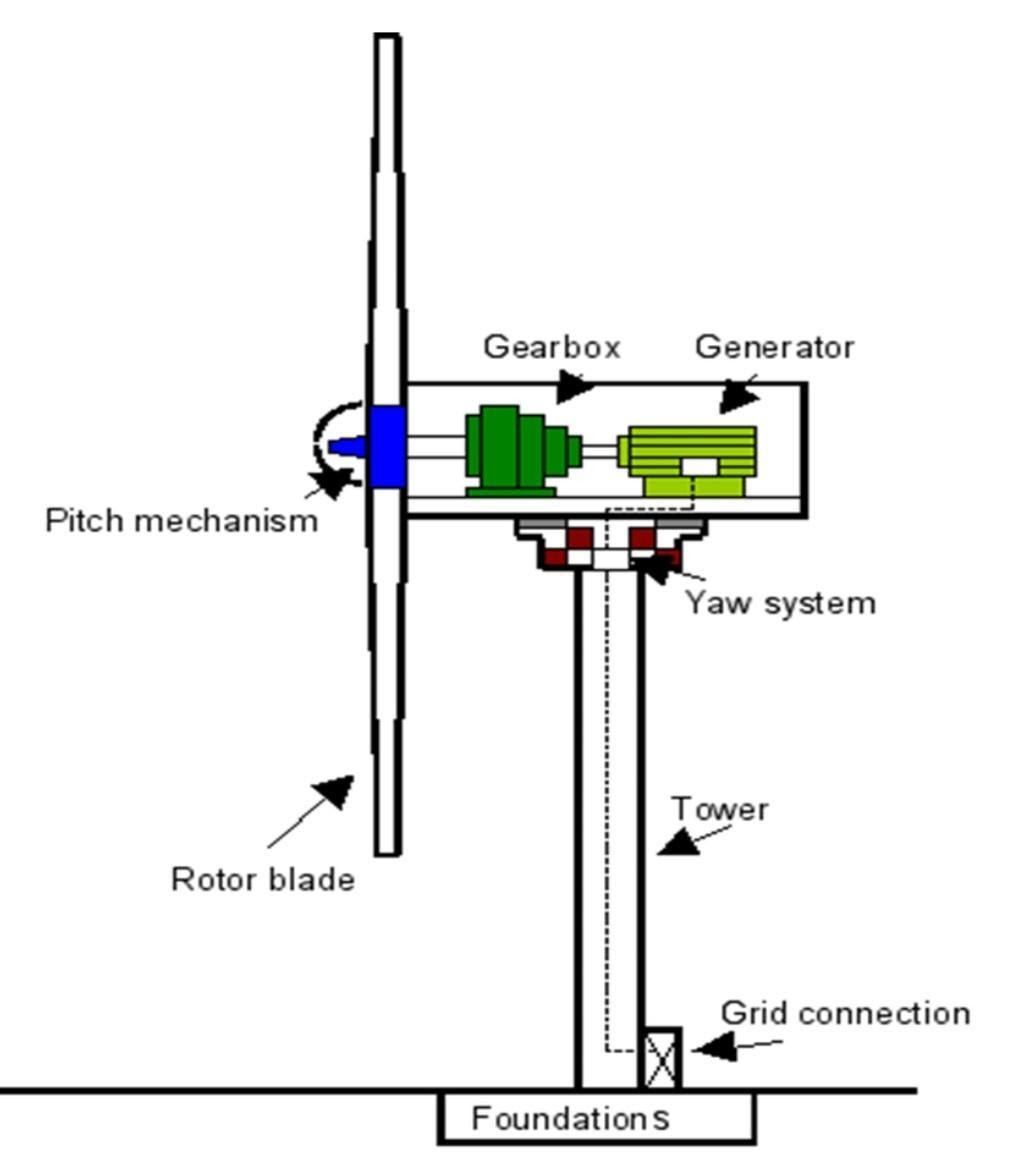How to Make a Windmill - Definition, Types, Uses & Components, FAQs
A windmill could be a machine that tackles the use of wind. Windmills may be utilized to pound grain into flour, to pump water, or to create power. A Windmill meaning is a machine that tackles the control of the wind and uses wind energy to generate electricity. In this article, we will understand in detail what is windmill, how to make a windmill, how a windmill works, the uses of windmills, the different types of windmills, advantages and disadvantages of windmills.
This Story also Contains
- What is Windmill
- How Windmills are Made?
- Components of Windmill
- How a Windmill Work?
- Different Types Of Windmills
- What are the Uses of Windmills?
- Advantages of Windmill
- Disadvantages Of Windmill

What is Windmill
Windmill definition: Windmill is a mechanical device that converts kinetic energy into mechanical energy. As the wind blows, the rotational movement of the blades is used to produce mechanical energy. It typically contains a set of blades attached to a central shaft.
How Windmills are Made?
Construction Process of Wind Turbines and how to make a wind turbine. Windmill parts are a tower, rotor, nacelle, and base. The following steps are taken for windmill structure construction:
- First, the tower is developed. The steel segments of the tower may be made offsite in a production line but they are regularly collected on the location. The parts are locked together and the tower is kept in a flat position till it is set. Then the tower is raised into the position by a crane, bolts are fixed and on accomplishment, reliability is tested.
- Next, the fiberglass nacelle is introduced. The gearbox, fundamental drive shaft, yaw controls, and blade pitch are collected and mounted onto a base outline at a production line. The nacelle is projected covering the gear and at the location, the nacelle is lifted on the completed tower and settled. The nacelle is made of fiberglass and incorporates the gearbox and the main drive shaft.

- Experimentation with unused materials for the blades has taken put. In commercial wind turbines, fiberglass with an empty center is utilized for the blades, in some cases, aluminum and lightweight wood are also used. Aluminum blades are made by blasting aluminum sheets together, and wooden edges are carved shaping a streamlined propeller with a comparable cross-section as found on a plane wing. The fiberglass edge is comparatively monotonous. To begin with, a blade is made by molding it into two halves.
- The internal surfaces of the mold are coated with fiberglass-resin composite blend. The fiberglass blend must dry for a few hours and an air-filled bladder within the shape makes a difference it to hold its shape. The shape is unbolted after the fiberglass is dry and the bladder is taken out. The blade at that point is cleaned, sanding is done and the two halves are fixed and after that painted.
- The blades are ordinarily catapulted on the nacelle after putting it on the tower. Ordinarily, a three-pronged edge has two edges on the nacelle some time recently it is lifted and the third edge is blasted after the nacelle is in place. The utility box for the wind turbines and electrical communication framework for the wind farm is introduced besides placing the blades and nacelle.
Related Topic,
Components of Windmill
- Blades: These are large flat surfaces with rotational movement.
- Rotor: It is the group of blades that spins when the wind moves the blades
- Shaft: It connects the rotor to other components inside the windmill.
- Gearbox: It adjusts the rotational speed of the rotor shaft.
- Tower: The tower supports the rotor and can be made of wood, stone, or metal.
- Tail: Located at the backside of the tower which is a small surface that helps in the orientation of blades into the wind.
How a Windmill Work?
The Windmill's function is to help man convert the energy contained in wind to several different helpful forms for the last 2 thousand years. What are windmills used for? Nowadays wind turbines are capable of changing a good quantity of energy within the wind into electricity. This is often due to the blades that are developed by using state-of-the-art mechanics analysis and also the different performance-enhancing equipment. What kind of energy does a wind turbine use? The answer is mechanical energy. Now let us study windmills and how windmills work step by step.
1st let' get into its basic working. The blade incorporates a ton of device cross sections consisting of various sizes and shapes from the basis to the tip. The easy airfoil technology makes the turbine blade turn which means that a raised force is created once a fluid moves over an airfoil. This way the turbine achieves the fundamental rotation. The wind turbine blade is sited in a leaning manner to line up with the relative wind speed. As the blade rate increases to the tip the relative wind speed becomes a lot of inclined towards the tip. This suggests that a nonstop twist is given to the blade from the basis to the tip.
But this rotation can't be directly coupled to a generator as a result of the turbine blades generally flipping at an awfully low rate of RAM because of the problems of the noise and mechanical strength. Considering this low-speed rotation we cannot turn out any substantive electricity frequency from a generator. Thus before connecting to the generator, the speed is enlarged in a gearbox. The gearbox uses an epicycle gear set arrangement to realize the high-speed magnitude relation, speed ratio = 1:90.
A prospect conjointly sits within the nacelle. The operation of the brake is to arrest wind blade rotation throughout the windy conditions and the cutoff speed is equal to 80 km/hr. Consequently, the electricity that's created is established through the cables towards the bottom wherever a step-up transformer is situated. The turbine ought to face the wind normally to maximize power extraction. A velocity sensor is close-fitted on the top of the nacelle which measures the wind speed and direction. The deviation within the wind's direction is shipped to an electronic controller that successively sends an applicable signal to the yawning mechanism to correct the error. In keeping with the wind speed the relative velocity angle of the wind conjointly changes.
A blade tilting mechanism tilts the blade and assures a correct orientation of the blade with the relative velocity. Hence the blades are always at the optimal angle of outbreak with the relative wind flow. The blade absorbs some mechanical energy from the wind. The same amount of energy is converted as the mechanical power of the turbine. It’s interesting to notice that a wind turbine absorbs one hundred percent of the obtainable kinetic energy as long as the downstream wind speed becomes zero. But zero wind speed downstream is physically not a possible condition.
Zero downstream speed merely means that the entire flow is stock. This physical reality of the flow demands an exact quantity of exit wind speed. This means that there is a theoretical maximum efficiency of a turbine can achieve. This limit is named Betz's limit. Basically, it implies that no wind turbine in the world can ever cross the efficiency limit of 59.3 percent.
Different Types Of Windmills
- Post mill: It has a horizontal axis and a rotating body mounted on a central post.
- Tower mill: It has a vertical axis with the mill's machinery and rotating blades located at the top of the tower
- Smock mill: Wooden with a smock structure.
- Horizontal axis wind turbine: It has blades attached to a horizontal axis. Used for generating electricity.
- Vertical axis wind turbine: It has blades attached to a vertical axis. Used in small-scale applications.
What are the Uses of Windmills?
Here are the 5 uses of windmills:
- Pounding of grains
- Pounding of flavors
- To pump water
- To obtain electricity
- For sawing wood
Advantages of Windmill
- Renewable energy resource
- It is environment friendly
- Low operating cost
- Contributes to job opportunities
- Efficient use of land
Disadvantages Of Windmill
- Dependence on wind
- High initial costs
- Dependent on weather
- Birds and bats can collide with windmill turbines impacting wildlife badly.
- Blades creates noise
Also read:
Frequently Asked Questions (FAQs)
Windmills make use of wind energy to produce power.
windmills are capable of changing a good quantity of energy within the wind into electricity.
Yes, a wind turbine is a type of wind mill.
Windmill parts are a tower, rotor, nacelle and a base.
To pump water and to obtain electricity.